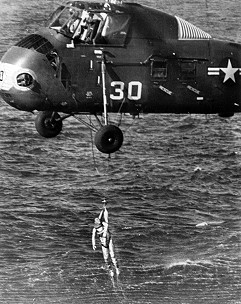The
Mercury-Redstone 4, MR-4 or Liberty Bell 7 spaceflight
was second first human spaceflight by the USA and took place on July 21, 1961,
with Virgil
Grissom as the astronaut. This second manned mission by the
USA, however, was only a 15-minute suborbital flight meaning above the limit of
space at an altitude of 100 km (54 nmi) and down again. The last part of the
mission name came from the Redstone rocket that was used for launching the
spacecraft. The Redstone rocket was not able to boost a
Mercury spacecraft into an Earth orbit.
The
launch of Liberty Bell 7 was first planned for July 16, 1961. The cloud cover
was too thick and the launch was postponed until July 18, 1961. On July 18,
1961 it was again postponed due to weather. Both times, the pilot had not yet
boarded the spacecraft. On July 19, 1961, Virgil
Grissom was aboard the Liberty Bell 7 when the flight was
delayed again due to weather. At that point, it had just 10 minutes 30 seconds
to go before launch.
Turning reluctantly to his dials and control stick,
Virgil
Grissom made a pitch movement change, but was past his
desired mark. He jockeyed the hand-controller stick for position, trying to
damp out all oscillations, then made a yaw movement and went too far in that
direction. By the time the proper attitude was attained, the short time
allocated for these maneuvers had been used, so he omitted the roll movement
altogether. Virgil
Grissom found the manual controls very sluggish when compared
to the
Mercury procedures trainer. He then switched to the
new rate command control system and found perfect response, although fuel
consumption was high. After the pitch and yaw maneuvers, Virgil
Grissom made a roll-over movement so he could see the ground
from his window.
The reentry was without any problems. Virgil
Grissom - as he told later - could not feel the oscillations
following the acceleration buildup; he could only read them on the rate
indicators. The drogue parachute deployed on schedule at 21,000 ft (6.4 km).
Virgil
Grissom said he saw the deployment and felt some resulting
pulsating motion, but not enough to worry him. Main parachute deployment
occurred at 12,300 ft (3.7 km), which was about 1,000 ft (300 m) higher than
the design nominal altitude. Watching the main chute unfurl, Virgil
Grissom spotted a 6 in (150 mm) L-shaped tear and another 2
in (51 mm) puncture in the canopy. Although he worried about them, the holes
grew no bigger and his rate of descent soon slowed to about 28 ft/s (8.5 m/s).
Dumping his peroxide control fuel, the pilot began transmitting his panel
readings.
After the splashdown Virgil
Grissom then removed his oxygen hose and opened his visor.
Suddenly the hatch cover blew away, and salt water swished into the spacecraft
as it bobbed in the ocean. The Liberty Bell 7 began taking on water and was
sinking fast. He removed his helmet, grasped the instrument panel with his
right hand, and climbed out of the sloshing hatchway. Floating in the sea, he
was thankful that he had unbuckled himself earlier from most of his harness,
including the chest restraints, otherwise he might not have been able to
exit.
Virgil
Grissom realized that he was not riding as high in the water
as he had been. All the time he had been in the water he kept feeling air
escape through the neck dam. The more air he lost, the less buoyancy he had.
Moreover, he had forgotten to secure his suit inlet valve. Swimming was
becoming difficult, and now with the second helicopter moving in he found the
rotor wash between the two aircraft was making swimming more difficult.
Finally, one of the helicopters tossed the "horse-collar" lifeline straight to
Virgil
Grissom, who immediately wrapped himself into the sling
backwards. Lack of orthodoxy mattered little to Virgil
Grissom now, for he was on his way to the safety of the
helicopter, even though swells dunked him twice more before he got aboard. He
was flown to the destroyer
USS
Randolph.
As the first helicopter moved away from Virgil
Grissom, it struggled to raise the spacecraft high enough to
drain the water from the impact bag. At one point the spacecraft was almost
clear of the water, but like an anchor it prevented the helicopter from moving
forward. The flooded Liberty Bell 7 weighed over 5,000 pounds (2,300 kg), 1,000
lb (450 kg) beyond the helicopter's lifting capacity. The pilot, watching his
insistent red warning light, decided not to chance losing two craft in one day.
He finally cast loose, allowing the spacecraft to sink swiftly.
In
March 1965 Virgil
Grissom became Command Pilot of the first U.S. two-person
spaceflight
Gemini
3. He was scheduled the fly
Apollo 1 as
Commander in February 1967. During a launch simulation on January 27, 1967 the
Command Module interior caught fire and burned. Virgil
Grissom died together with his crewmates Edward
White and Roger
Chaffee.
![]()



![]()















